
° Semiconductor
MSM7717-01/02/03
1/19
° Semiconductor
MSM7717-01/02/03
Single Rail CODEC
GENERAL DESCRIPTION
The MSM7717 is a single-channel CODEC CMOS IC for voice signals ranging from 300 to 3400
Hz with filters for A/D and D/A conversion.
Designed especially for a single-power supply and low-power applications, the device is
optimized for ISDN terminals and telephone terminals in digital wireless systems.
The device uses the same transmission clocks as those used in the MSM7508B and MSM7509B.
The analog output, which can drive a 1.2 kW load, can directly drive a handset receiver
differentially.
FEATURES
∑ Single power supply: 2.7 V to 3.8 V
∑ Low power consumption
Operating mode:
20 mW Typ. V
DD
= 3 V
Power-down mode:
0.03 mW Typ. V
DD
= 3 V
∑ Conforms to ITU-T Companding law
MSM7717-01:
m/A-law pin selectable
MSM7717-02:
m-law
MSM7717-03:
A-law
∑ Built-in PLL eliminates a master clock
∑ Serial data rate: 64/128/256/512/1024 kHz
96/192/384/768/1536/1544/2048/200 kHz
∑ Adjustable transmit gain
∑ Adjustable receive gain
∑ Built-in reference voltage supply
∑ Package options:
24-pin plastic SOP (SOP24-P-430-1.27-K)
(Product name: MSM7717-01GS-K)
(Product name: MSM7717-02GS-K)
(Product name: MSM7717-03GS-K)
20-pin plastic SSOP (SSOP20-P-250-0.95-K) (Product name: MSM7717-01MS-K)
(Product name: MSM7717-02MS-K)
(Product name: MSM7717-03MS-K)
E2U0041-28-81
This version: Aug. 1998
Previous version: Nov. 1996
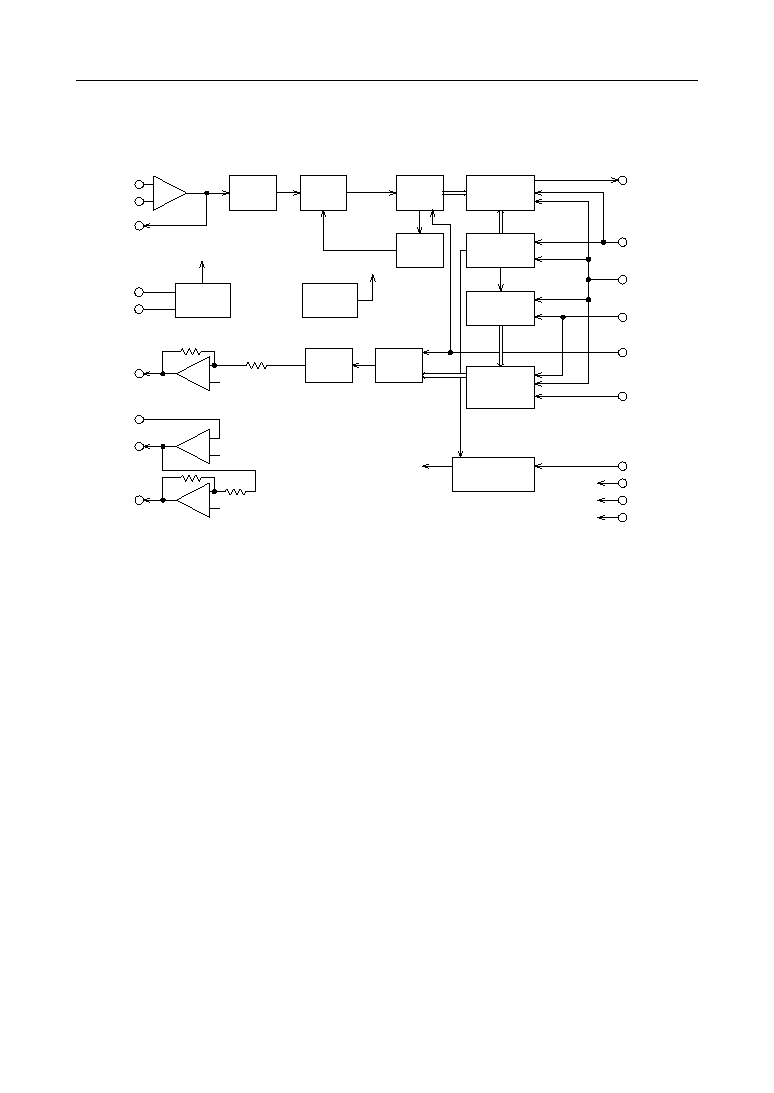
° Semiconductor
MSM7717-01/02/03
2/19
BLOCK DIAGRAM
RC
LPF
8th
BPF
AD
CONV.
TCONT
AUTO
ZERO
5th
LPF
DA
CONV.
PWD
Logic
PLL
RTIM
RCONT
PCMOUT
PCMIN
PDN
V
DD
AG
DG
SG
GEN
SGC
SG
PWD
≠
+
AIN≠
AIN+
GSX
≠
+
VFRO
SG
RSYNC
BCLK
XSYNC
(ALAW)
VR
GEN
≠
+
AOUT≠
SG
PWI
≠
+
AOUT+
SG

° Semiconductor
MSM7717-01/02/03
3/19
PIN CONFIGURATION (TOP VIEW)
1
2
3
4
5
6
7
8
9
10
11
12
13
14
15
16
17
18
19
20
SG
AOUT+
AOUT≠
PWI
VFRO
V
DD
DG
PDN
SGC
AIN+
AIN≠
GSX
AG
BCLK
NC : No connect pin
RSYNC
PCMIN
XSYNC
PCMOUT
1
2
3
4
5
6
7
8
9
10
11
12
13
14
15
16
17
18
19
20
21
22
23
24
SG
AOUT+
AOUT≠
PWI
VFRO
DG
PDN
SGC
AIN+
AIN≠
GSX
AG
NC : No connect pin
RSYNC
PCMIN
XSYNC
PCMOUT
V
DD
BCLK
(ALAW)*
NC
NC
NC
(ALAW)*
NC
NC
NC
20-Pin Plastic SSOP
24-Pin Plastic SOP
* The ALAW pin is only supported by the MSM7717-01GS-K/MSM7717-01MS-K.
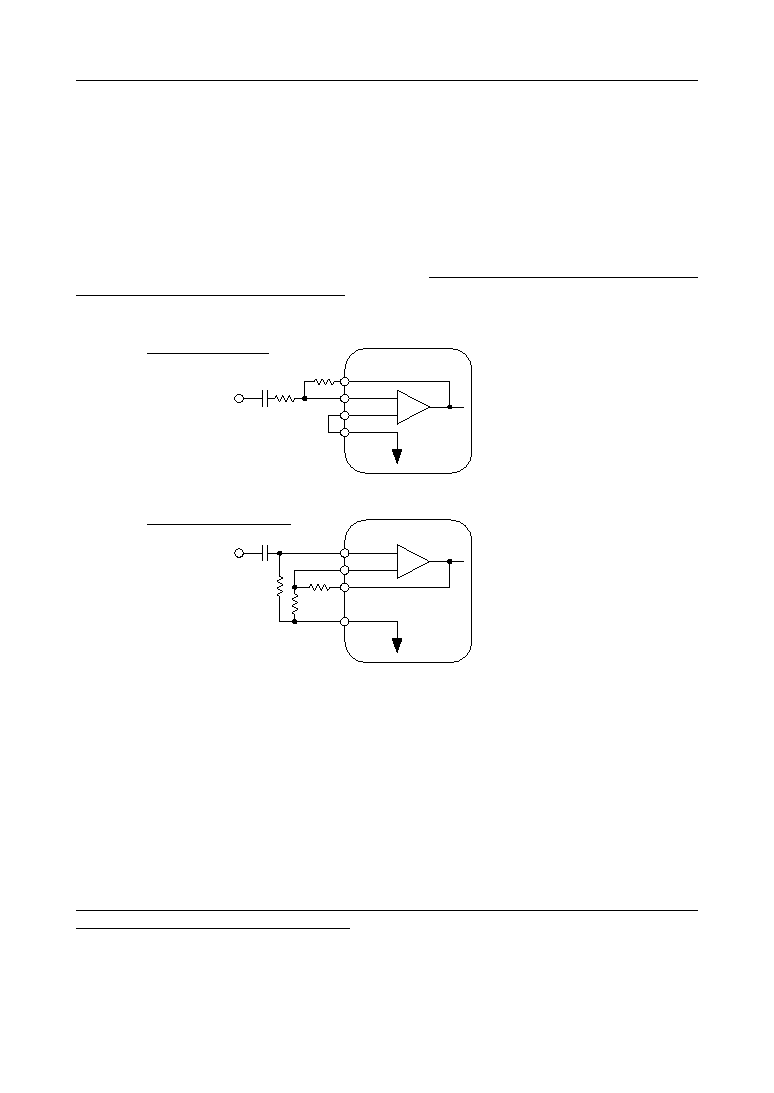
° Semiconductor
MSM7717-01/02/03
4/19
PIN AND FUNCTIONAL DESCRIPTIONS
AIN+, AIN≠, GSX
Transmit analog input and transmit level adjustment.
AIN+ is a non-inverting input to the op-amp; AIN≠ is an inverting input to the op-amp; GSX is
connected to the output of the op-amp.
The level adjustment should be performed in any method shown below. When not using AIN≠
and AIN+, connect AIN≠ to GSX and AIN+ to SG. During power-saving and power-down
modes, the GSX output is at AG voltage.
AG
Analog signal ground.
VFRO
Receive filter output.
The output signal has an amplitude of 2.0 V
PP
above and below the signal ground voltage (SG)
when the digital signal of +3 dBm0 is input to PCMIN and can drive a load of 20 kW or more.
For driving a load of less than 20 kW, connect a resistor of 20 kW or more between the pins VFRO
and PWI.
During power-saving mode this output is in a high impedance state, and during power-down
mode, the VFRO output is at an SG level.
When adjusting the receive signal on the basis of frequency characteristics, refer to the Frequency
Characteristics Adjustment Circuit.
≠
+
AIN≠
AIN+
C1
Analog input
1) Inverting input type
R1 : variable
R2 > 20 kW
C1 > 1/(2 • 3.14 • 30 • R1) (F)
Gain = R2/R1 < 10
R2
GSX
SG
+
≠
AIN+
AIN≠
2) Noninverting input type
R3 > 20 kW
R4 > 20 kW
R5 > 50 kW
C2 > 1/ (2 • 3.14 • 30 • R5) (F)
Gain = 1 + R4 / R3 £ 10
R4
GSX
SG
C2
Analog input
R3
R5
R1

° Semiconductor
MSM7717-01/02/03
5/19
PWI, AOUT+, AOUT≠
PWI is connected to the inverting input of the receive driver.
The receive driver output is connected to the AOUT≠ pin. Therefore, the receive level can be
adjusted with the pins VFRO, PWI, and AOUT≠. When the PWI pin is not used, the PWI pin to
the AOUT≠ pin, and leave the pins AOUT≠ and AOUT+ open. The output of AOUT+ is inverted
with respect to the output of AOUT≠. Since these outputs provide differential drive of an
impedance of 1.2 kW, these outputs can directly be connected to a receiver of handset using a
piezoelectric earphone. Refer to the application example. Since the driver amplifiers are being
activated during the power-saving mode, the amplifiers can output other external signals from
AOUT+ and AOUT≠ pins. AOUT+ and AOUT≠ outputs are in a high impedance state during
the power-down mode.
V
DD
Power supply for 2.7 V to 3.8 V. (Typically 3.0 V)
PCMIN
PCM data input.
A serial PCM data input to this pin is converted to an analog signal in synchronization with the
RSYNC signal and BCLK signal.
The data rate of PCM is equal to the frequency of the BCLK signal.
PCM signal is shifted in at a falling edge of the BCLK signal and latched into the internal register
when shifted by eight bits.
The start of the PCM data (MSD) is identified at the rising edge of RSYNC.
BCLK
Shift clock signal input for the PCMIN and PCMOUT signal.
The frequency, equal to the data rate, is 64, 96, 128, 192, 256, 384, 512, 768, 1024, 1536, 1544, or 2048
kHz. Setting this signal to logic "1" or "0" drives both transmit and receive circuits to the power
saving state.
The power-saving state means that the reference voltage generator (VRGEN), PLL, and receive
driver amplifiers are in the operating mode and the other circuits are in the non-operating mode.
R6 > 20 kW
Gain = VO/VI = R7/R6 £ 1
R6
R7
≠
+
SG
≠
+
SG
VFRO
PWI
AOUT≠
AOUT+
ZL
Analog output
Analog inverted output
ZL > 1.2 kW
External Signal Input
Receive filter
VI
VO

° Semiconductor
MSM7717-01/02/03
6/19
RSYNC
Receive synchronizing signal input.
Eight required bits are selected from serial PCM signals on the PCMIN pin by the receive
synchronizing signal.
Signals in the receive section are synchronized by this synchronizing signal. This signal must be
synchronized in phase with the BCLK. The frequency should be 8 kHz
±
50 ppm to guarantee the
AC characteristics which are mainly the frequency characteristics of the receive section.
However, if the frequency characteristic of an applied system is not specified exactly, this device
can operate in the range of 8 kHz
±
2 kHz, but the electrical characteristics in this specification are
not guaranteed.
XSYNC
Transmit synchronizing signal input.
The PCM output signal from the PCMOUT pin is output in synchronization with this signal. This
synchronizing signal triggers the PLL and synchronizes all timing signals of the transmit section.
This synchronizing signal must be synchronized in phase with BCLK.
The frequency should be 8 kHz
±
50 ppm to guarantee the AC characteristics which are mainly
the frequency characteristics of the transmit section.
However, if the frequency characteristic of an applied system is not specified exactly, this device
operates in the range of 8 kHz
±
2 kHz, but the electrical characteristics in this specification are
not guaranteed.
Setting this signal to logic "1" or "0" drives both transmit and receive circuits to the power saving
state.
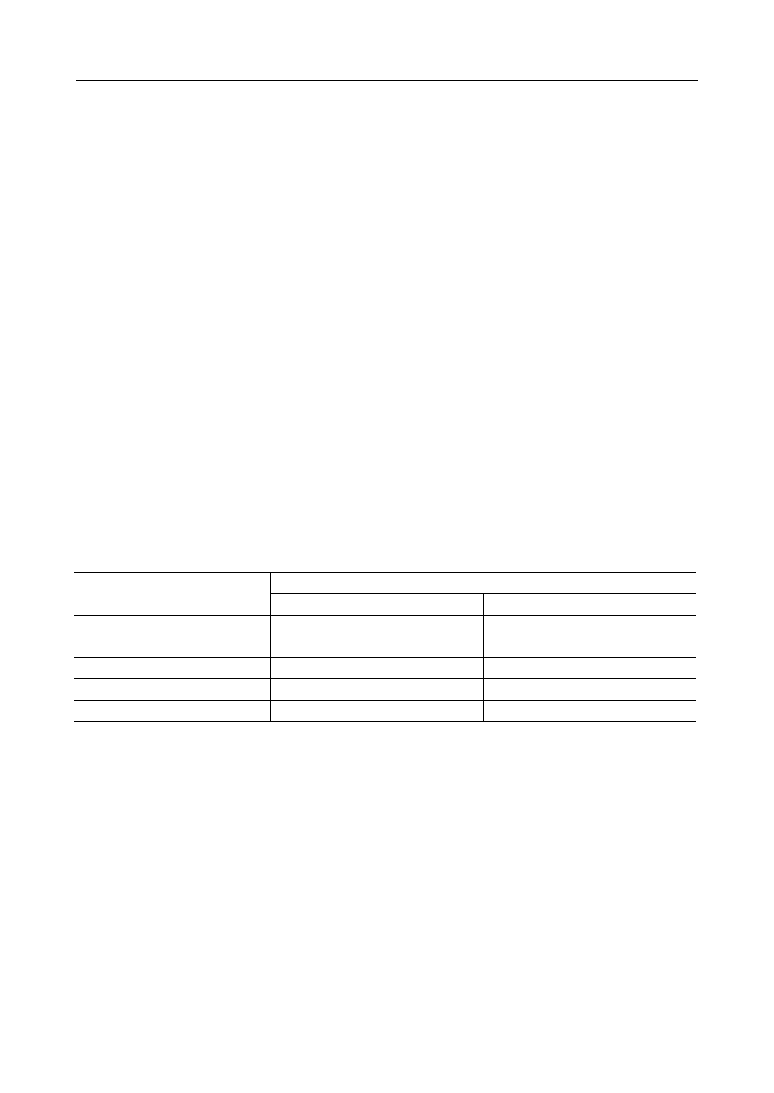
° Semiconductor
MSM7717-01/02/03
7/19
DG
Ground for the digital signal circuits.
This ground is separate from the analog signal ground AG. The DG pin must be connected to the
AG pin on the printed circuit board to make a common analog ground AG.
PDN
Power down control signal.
A logic "0" level drives both transmit and receive circuits to a power down state.
PCMOUT
PCM signal output.
Synchronizing with the rising edge of the BCLK signal, the PCM output signal is output from
MSD in a sequential order.
MSD may be output at the rising edge of the XSYNC signal, based on the timing between BCLK
and XSYNC.
This pin is in a high impedance state except during 8-bit PCM output. It is also in a high
impedance state during power saving or power down mode.
A pull-up resistor must be connected to this pin because its output is configured as an open drain.
This device is compatible with the ITU-T recommendation on coding law and output coding
format.
The MSM7717-03 (A-law) outputs the character signal, inverting the even bits.
Input/Output Level
+Full scale
+0
≠0
≠Full scale
PCMIN/PCMOUT
MSM7717-02 (
m-law)
MSD
1
0
0
0
0
0
0
0
1
1
1
1
1
1
1
1
0
1
1
1
1
1
1
1
0
0
0
0
0
0
0
0
MSM7717-03 (A-law)
MSD
1
0
1
0
1
0
1
0
1
1
0
1
0
1
0
1
0
1
0
1
0
1
0
1
0
0
1
0
1
0
1
0

° Semiconductor
MSM7717-01/02/03
8/19
SG
Signal ground voltage output.
The output voltage is 1/2 of the power supply voltage.
The output drive current capability is
±
200 mA.
This pin provides the SG level for CODEC peripherals.
This output voltage level is undefined during power-saving or power-down mode.
SGC
Used to generate the signal ground voltage level by connecting a bypass capacitor.
Connect a 0.1 mF capacitor with excellent high frequency characteristics between the AG pin and
the SGC pin.
ALAW
Control signal input of the companding law selection.
Only the MSM7717-01GS-K/7717-01MS-K has this pin. The CODEC will operate in the m-law
when this pin is at a logic "0" level and the CODEC will has this pin operate in the A-law when
this pin is at a logic "1" level. The CODEC operates in the m-law if the pin is left open, since the
pin is internally pulled down.

° Semiconductor
MSM7717-01/02/03
9/19
ABSOLUTE MAXIMUM RATINGS
RECOMMENDED OPERATING CONDITIONS
Unit
Max.
Typ.
Min.
Condition
Symbol
Parameter
V
3.8
3.0
2.7
Voltage must be fixed
V
DD
Power Supply Voltage
∞C
+85
+25
≠30
--
Ta
Operating Temperature
V
PP
1.4
--
--
Connect AIN≠ and GSX
V
AIN
Analog Input Voltage
V
V
DD
--
0.45•V
DD
XSYNC, RSYNC, BCLK,
PCMIN, PDN, ALAW
V
IH
High Level Input Voltage
V
0.16•V
DD
--
0
V
IL
Low Level Input Voltage
64, 128, 256, 512, 1024,
2048, 96, 192, 384, 768,
1536, 1544, 200
BCLK
F
C
Clock Frequency
kHz
kHz
10
8.0
6.0
XSYNC, RSYNC
F
S
Sync Pulse Frequency
%
60
50
40
BCLK
D
C
Clock Duty Ratio
ns
50
--
--
XSYNC, RSYNC, BCLK,
PCMIN, PDN, ALAW
t
lr
Digital Input Rise Time
ns
50
--
--
t
lf
Digital Input Fall Time
Transmit Sync Pulse Setting Time
ns
--
--
100
BCLK∆XSYNC, See Fig. 1
t
XS
ns
--
--
100
XSYNC∆BCLK, See Fig. 1
t
SX
Receive Sync Pulse Setting Time
ns
--
--
100
BCLK∆RSYNC, See Fig. 1
t
RS
ns
--
--
100
RSYNC∆BCLK, See Fig. 1
t
SR
ms
--
--
1 BCLK
XSYNC, RSYNC, See Fig. 1
t
WSH
High Level Sync Pulse Width
ms
--
--
1 BCLK
XSYNC, RSYNC, See Fig. 1
t
WSL
Low Level Sync Pulse Width
ns
--
--
100
See Timing Diagram
t
DS
PCMIN Setup Time
ns
--
--
100
See Timing Diagram
t
DH
PCMIN Hold Time
kW
--
--
0.5
Pull-up resistor
R
DL
pF
100
--
--
--
C
DL
Digital Output Load
mV
+100
--
≠100
Transmit gain stage, Gain = 1
V
off
mV
+10
--
≠10
Transmit gain stage, Gain = 10
Analog Input Allowable DC Offset
ns
1000
--
--
XSYNC, RSYNC, BCLK
--
Allowable Jitter Width
Parameter
Power Supply Voltage
Analog Input Voltage
Digital Input Voltage
Storage Temperature
Symbol
V
DD
V
AIN
V
DIN
T
STG
Condition
--
--
--
--
Rating
≠0.3 to +7
≠0.3 to VDD + 0.3
≠0.3 to VDD + 0.3
≠55 to +150
Unit
V
V
V
∞C

° Semiconductor
MSM7717-01/02/03
10/19
ELECTRICAL CHARACTERISTICS
DC and Digital Interface Characteristics
Parameter
Power Supply Current
High Level Input Voltage
Low Level Input Voltage
High Level Input Leakage Current
Low Level Input Leakage Current
Digital Output Low Voltage
Digital Output Leakage Current
Input Capacitance
Symbol
I
DD1
I
DD3
I
DD2
V
IH
V
IL
I
IH
I
IL
V
OL
I
O
Condition
Operating mode
Power-saving mode, PDN = 1,
BCLK or XSYNC ∆ OFF
Power-down mode, PDN = 0,
BCLK OFF
--
--
Pull-up resistor > 500 W
Min.
--
--
--
0.45•V
DD
0.0
--
--
0.0
--
Typ.
10
2.0
0.005
--
--
--
--
0.2
--
Max.
14
8.0
0.05
V
DD
0.16•V
DD
2.0
0.5
0.4
10
Unit
mA
mA
mA
V
V
mA
mA
V
mA
C
IN
--
--
5
--
pF
(V
DD
= 2.7 V to 3.8 V, Ta = ≠30∞C to +85∞C)
--
No signal
--
6.5
10.0
V
DD
= 3.8 V
V
DD
= 3.0 V
XSYNC, RSYNC, BCLK,
PCMIN, PDN, ALAW
XSYNC, RSYNC, BCLK,
PCMIN, PDN, ALAW

° Semiconductor
MSM7717-01/02/03
11/19
Transmit Analog Interface Characteristics
Receive Analog Interface Characteristics
Input Resistance
Output Load Resistance
Output Load Capacitance
R
INPW
R
LVF
R
LAO
C
LVF
C
LAO
PWI
10
20
0.6
--
--
--
--
--
--
--
--
--
--
30
50
MW
kW
kW
pF
pF
VFRO with respect to SG
Output Amplitude
Offset Voltage
V
OVF
V
OAO
V
OSVF
V
OSAO
≠1.0
≠1.0
≠100
≠100
--
--
--
--
+1.0
+1.0
+100
+100
V
V
mV
mV
VFRO, R
L
= 20 kW with
respect to SG
AOUT+, AOUT≠ (each) with
respect to SG
VFRO
AOUT+, AOUT≠
AOUT+, AOUT≠, R
L
= 0.6 kW
with respect to SG
VFRO with respect to SG
AOUT+, AOUT≠, Gain = 1 with
respect to SG
Parameter
Symbol
Condition
Min.
Typ.
Max.
Unit
(V
DD
= 2.7 V to 3.8 V, Ta = ≠30∞C to +85∞C)
Input Resistance
Output Load Resistance
Output Load Capacitance
Output Amplitude
Offset Voltage
R
INX
R
LGX
C
LGX
V
OGX
V
OSGX
AIN+, AIN≠
Gain = 1
10
20
--
≠0.7
≠20
--
--
--
--
--
--
--
30
+0.7
+20
MW
kW
pF
V
mV
GSX with respect to SG
Parameter
Symbol
Condition
Min.
Typ.
Max.
Unit
(V
DD
= 2.7 V to 3.8 V, Ta = ≠30∞C to +85∞C)
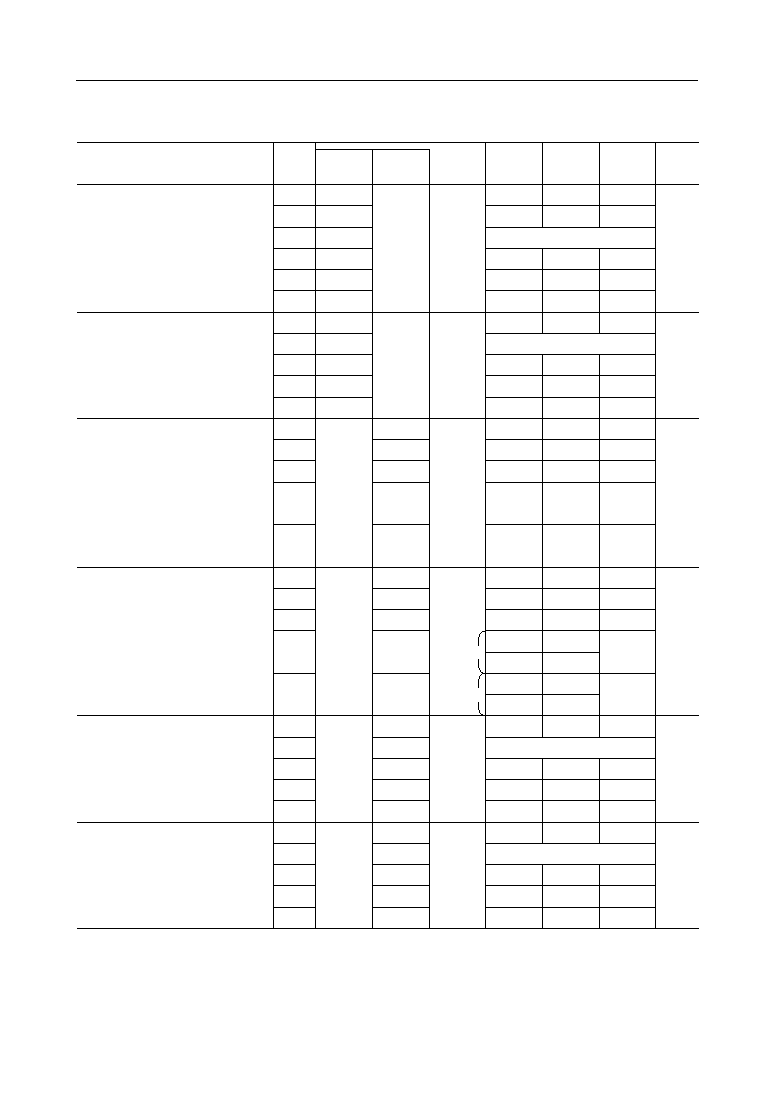
° Semiconductor
MSM7717-01/02/03
12/19
AC Characteristics
Condition
(F
S
= 8 kHz, V
DD
= 2.7 V to 3.8 V, Ta = ≠30∞C to +85∞C)
Parameter
Symbol
Min.
Typ.
Max.
Unit
Transmit Frequency Response
Loss T1
Level
(dBm0)
60
20
26
--
Freq.
(Hz)
Loss T2
300
≠0.15
+0.07
+0.2
Loss T3
1020
Reference
dB
0
Loss T4
2020
≠0.15
≠0.01
+0.2
Loss T5
3000
≠0.15
+0.15
+0.2
Loss T6
3400
0
0.4
0.8
Receive Frequency Response
Loss R1
300
≠0.15
≠0.03
+0.2
Loss R2
1020
Reference
Loss R3
2020
≠0.15
≠0.02
+0.2
dB
0
Loss R4
3000
≠0.15
+0.15
+0.25
Loss R5
3400
0
0.56
0.8
SD T1
35
43
--
3
SD T2
35
41
--
0
SD T3
35
38
--
≠30
Transmit Signal to Distortion Ratio
1020
dB
SD T4
28
30
--
≠40
SD T5
23
25
--
≠45
SD R1
36
43
--
3
SD R2
36
41
--
0
SD R3
36
40
--
≠30
Receive Signal to Distortion Ratio
1020
dB
SD R4
33.5
--
≠40
SD R5
30
--
≠45
Transmit Gain Tracking
GT T1
≠0.3
+0.01
+0.3
GT T2
Reference
GT T3
1020
≠0.3
0
+0.3
dB
≠40
GT T4
≠0.6
≠0.03
+0.6
GT T5
≠1.2
+0.15
+1.2
3
≠10
≠50
≠55
Receive Gain Tracking
GT R1
≠0.3
≠0.06
+0.3
GT R2
Reference
GT R3
1020
≠0.3
≠0.02
+0.3
dB
GT R4
≠0.6
≠0.02
+0.6
GT R5
≠1.2
≠0.27
+1.2
≠40
3
≠10
≠50
≠55
*1
32
27
30
25
29
24
*1
*2
*2
*1 Psophometric filter is used.
*2 Upper columns are specified for the m-law, lower for the A-law.

° Semiconductor
MSM7717-01/02/03
13/19
AC Characteristics (Continued)
Absolute Level (Initial Difference)
Nidle T
--
--
≠72.5
≠70.5
≠68
dBm0p
Nidle R
--
≠76.5
AV T
0.338
0.35
0.362
AV R
0.483
0.5
0.518
Vrms
1020
Absolute Delay
AV Tt
≠0.2
--
+0.2
0
AV Rt
≠0.2
--
+0.2
Td
1020
--
--
0.6
ms
0
A to A
BCLK
= 64 kHz
Transmit Group Delay
t
GD
T1
--
0.19
0.75
t
GD
T2
--
0.11
0.35
t
GD
T3
--
0.02
0.125
0
t
GD
T4
--
0.05
0.125
ms
*5
0.07
t
GD
T5
--
0.75
Receive Group Delay
--
0.00
0.75
0.00
--
0.00
0.125
ms
0
--
0.09
0.125
--
0.12
0.75
--
≠74
Idle Channel Noise
--
--
AIN = SG
*1 *3
*1
dB
dB
V
DD
= 3.0 V
Ta = 25∞C
V
DD
= 2.7 V
to 3.8 V
Ta = ≠30
to 85∞C
Absolute Level
(Deviation of Temperature and Power)
500
600
1000
2600
2800
Crosstalk Attenuation
CR T
75
80
--
CR R
76
1020
dB
0
TRANS ∆ RECV
RECV ∆ TRANS
t
GD
R1
t
GD
R2
t
GD
R3
t
GD
R4
t
GD
R5
500
600
1000
2600
2800
*5
70
--
--
0.35
Condition
(F
S
= 8 kHz, V
DD
= 2.7 V to 3.8 V, Ta = ≠30∞C to +85∞C)
Parameter
Symbol
Min.
Typ.
Max.
Unit
Level
(dBm0)
Freq.
(Hz)
*4
*4
*2
*1 Psophometric filter is used.
*2 Upper column is specified for the m-law, lower for the A-law.
*3 Input "0" code to PCMIN.
*4 AVR is defined at VFRO output.
*5 With respect to minimum value of the group delay distortion

° Semiconductor
MSM7717-01/02/03
14/19
AC Characteristics (Continued)
*6 Measured under idle channel noise.
DIS
4.6 kHz to
30
32
--
dB
Digital Output Delay Time
t
SD
20
--
200
t
XD1
20
--
200
t
XD2
20
--
200
t
XD3
20
--
200
ns
Discrimination
0
0 to
4000 Hz
C
L
= 100 pF + 1 LSTTL
S
300 to
--
≠37.5
≠35
dBm0
Out-of-band Spurious
0
4.6 kHz to
IMD
fa = 470
--
≠52
≠35
dBm0
Intermodulation Distortion
≠4
2fa ≠ fd
PSR T
0 to
--
30
--
dB
Power Supply Noise Rejection Ratio
50 mV
PP
*6
PSR R
72 kHz
3400
fd = 320
50 kHz
100 kHz
Condition
(F
S
= 8 kHz, V
DD
= 2.7 V to 3.8 V, Ta = ≠30∞C to +85∞C)
Parameter
Symbol
Min.
Typ.
Max.
Unit
Level
(dBm0)
Freq.
(Hz)

° Semiconductor
MSM7717-01/02/03
15/19
TIMING DIAGRAM
PCM Data Input/Output Timing
BCLK
1
2
3
4
5
6
7
8
9
10
XSYNC
PCMOUT
D2
D3
D4
D5
D6
D7
D8
MSD
t
XS
t
SX
t
WSL
t
WSH
t
SD
t
XD1
t
XD2
t
XD3
BCLK
RSYNC
PCMIN
MSD
t
RS
t
SR
t
DS
t
DH
Transmit Timing
Receive Timing
,
When t
XS
£ 1/2 ∑ Fc, the Delay of the MSD bit is defined as t
XD1
.
When t
SX
£ 1/2 ∑ Fc, the Delay of the MSD bit is defined as t
SD
.
,
D2
D3
D4
D5
D6
D7
D8
t
WSL
1
2
3
4
5
6
7
8
9
10
t
WSH
Figure 1 Basic Timing
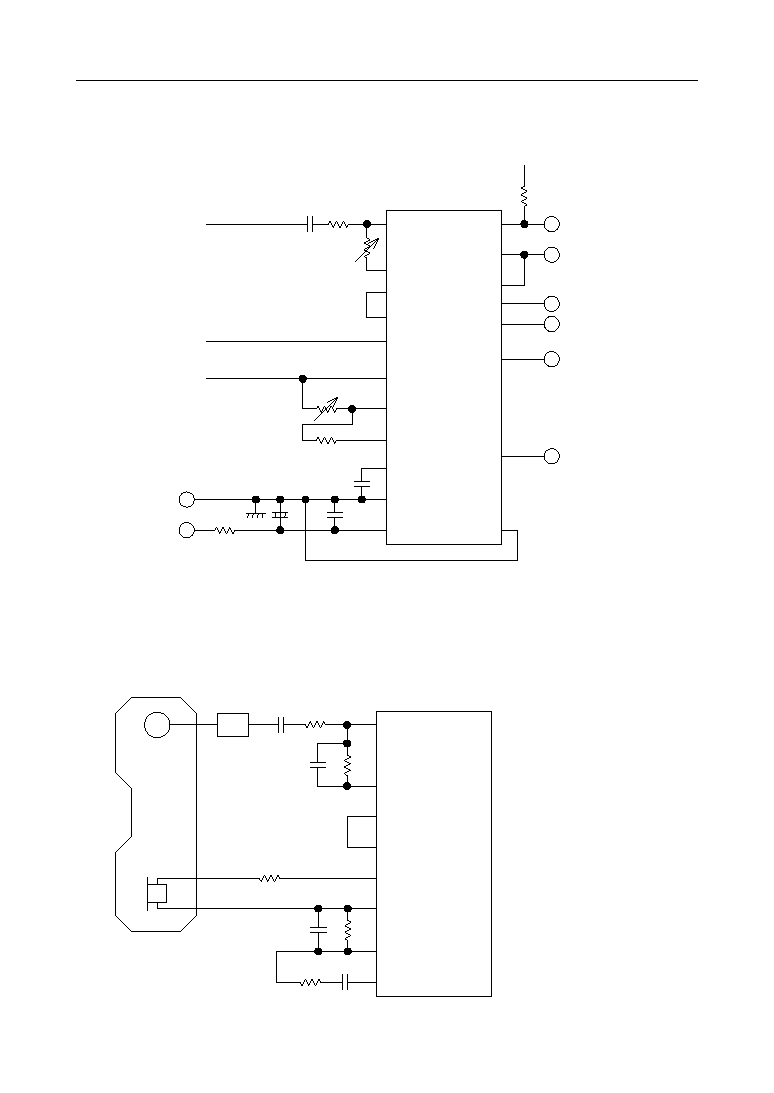
° Semiconductor
MSM7717-01/02/03
16/19
APPLICATION CIRCUIT
*
These output signals have amplitudes above and below the offset level of V
DD
/2.
FREQUENCY CHARACTERISTICS ADJUSTMENT CIRCUIT
AIN≠
Transmit frequency
characteristic
Adjustment determined by
C1, C2, R1 and R2
Receive frequency
characteristic
Adjustment determined by
C3, C4, R3 and R4
GSX
AIN+
SG
AOUT+
AOUT≠
PWI
VFRO
R2
C2
R4
C4
R1
C1
M
R3
C3
Microphone amp
R5
MSM7717-XX
PCMOUT
XSYNC
AIN≠
GSX
AIN+
1 mF
0.1 mF
PCM signal output
8 kHz SYNC signal input
PCM shift clock input
PCM data
Control of companding law
1: A-law
0: m-law
0.1 mF
51 kW
Analog input
AOUT+
SG
RSYNC
BCLK
PCMIN
ALAW
DG
AOUT≠
PWI
VFRO
SGC
AG
V
DD
0 V
+3 V
Analog inverted output*
51 kW
10 mF
+
MSM7717-01
PDN
0 to 10 W
Analog output*
+3 V
Power down control input
1: Normal operation
0: Power down

° Semiconductor
MSM7717-01/02/03
17/19
NOTES ON USE
∑ To ensure proper electrical characteristics, use bypass capacitors with excellent high frequency
characteristics for the power supply and keep them as close as possible to the device pins.
∑ Connect the AG pin and the DG pin as close as possible. Connect to the system ground with
low impedance.
∑ Mount the device directly on the board when mounted on PCBs. Do not use IC sockets. If the
use of IC socket is unavoidable, use the short lead type socket.
∑ When mounted on a frame, use electro-magnetic shielding, if any electro-magnetic wave
sources such as power supply transformers surround the device.
∑ Keep the voltage on the V
DD
pin not lower than ≠0.3 V even instantaneously to avoid latch-
up that may otherwise occur when power is turned on.
∑ Use a low noise (particularly, low level type of high frequency spike noise or pulse noise)
power supply to avoid erroneous operation and the degradation of the characteristics of these
devices.
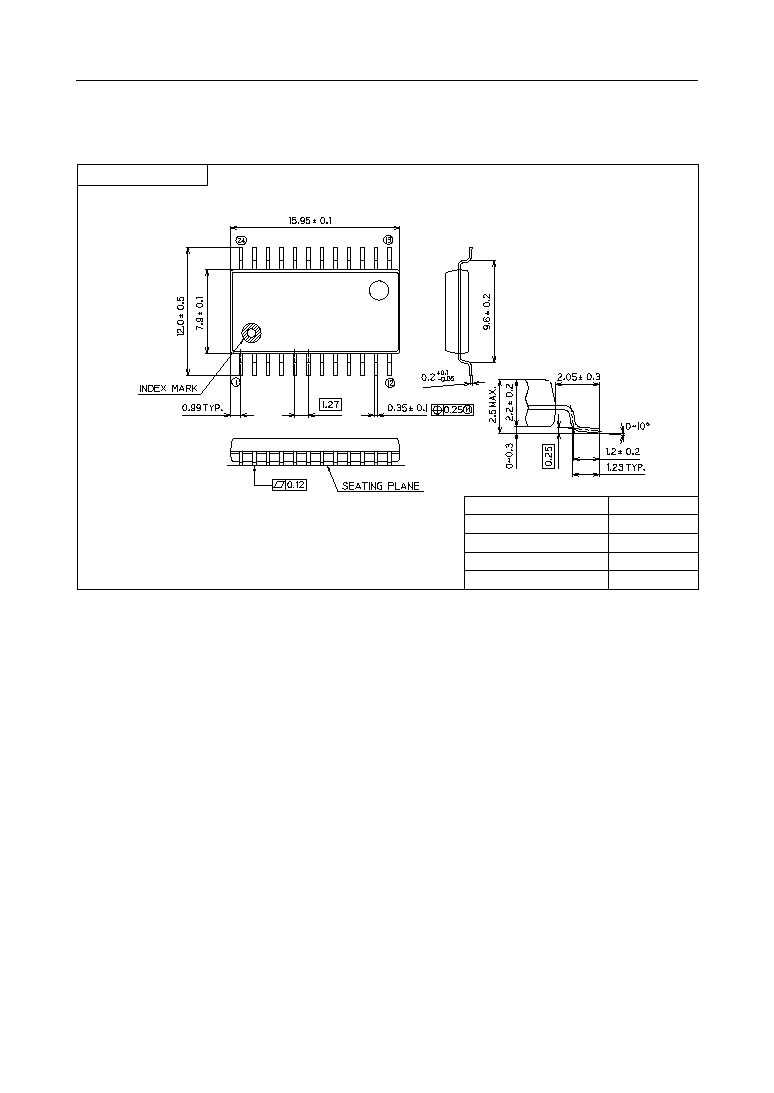
° Semiconductor
MSM7717-01/02/03
18/19
(Unit : mm)
PACKAGE DIMENSIONS
Notes for Mounting the Surface Mount Type Package
The SOP, QFP, TSOP, SOJ, QFJ (PLCC), SHP and BGA are surface mount type packages, which
are very susceptible to heat in reflow mounting and humidity absorbed in storage.
Therefore, before you perform reflow mounting, contact Oki's responsible sales person for the
product name, package name, pin number, package code and desired mounting conditions
(reflow method, temperature and times).
SOP24-P-430-1.27-K
Package material
Lead frame material
Pin treatment
Solder plate thickness
Package weight (g)
Epoxy resin
42 alloy
Solder plating
5 mm or more
0.58 TYP.
Mirror finish

° Semiconductor
MSM7717-01/02/03
19/19
(Unit : mm)
Notes for Mounting the Surface Mount Type Package
The SOP, QFP, TSOP, SOJ, QFJ (PLCC), SHP and BGA are surface mount type packages, which
are very susceptible to heat in reflow mounting and humidity absorbed in storage.
Therefore, before you perform reflow mounting, contact Oki's responsible sales person for the
product name, package name, pin number, package code and desired mounting conditions
(reflow method, temperature and times).
SSOP20-P-250-0.95-K
Package material
Lead frame material
Pin treatment
Solder plate thickness
Package weight (g)
Epoxy resin
42 alloy
Solder plating
5 mm or more
0.18 TYP.
Mirror finish


















